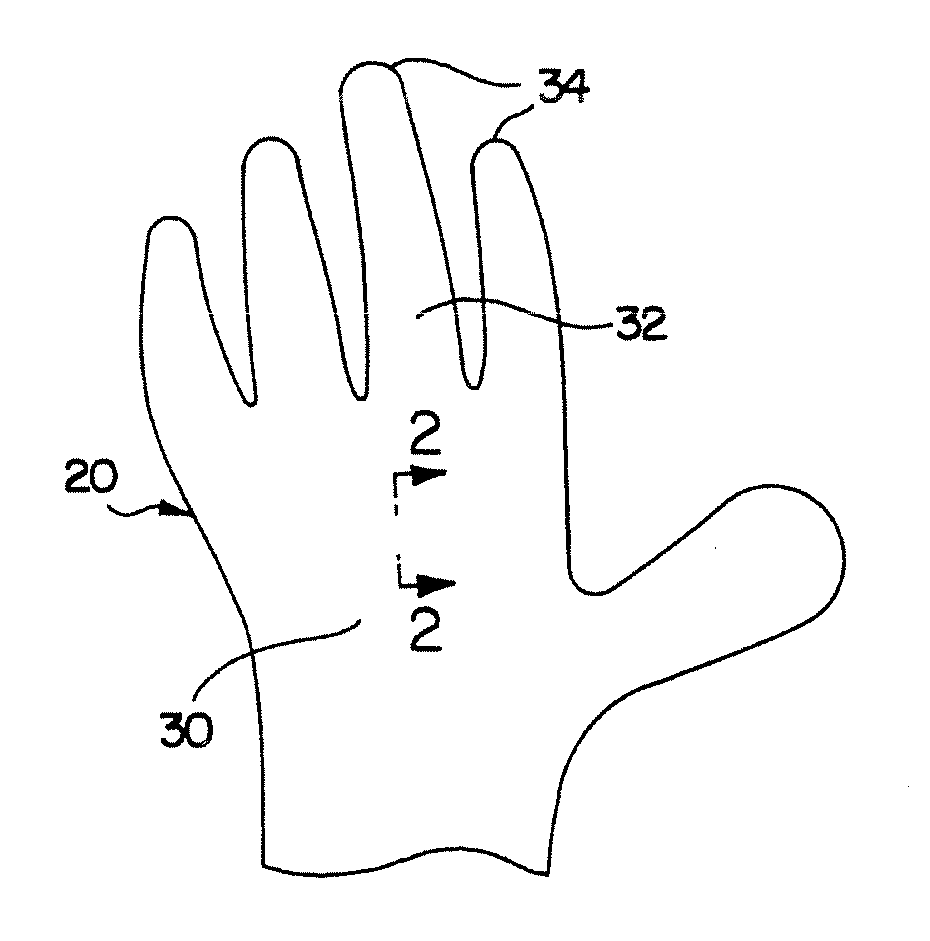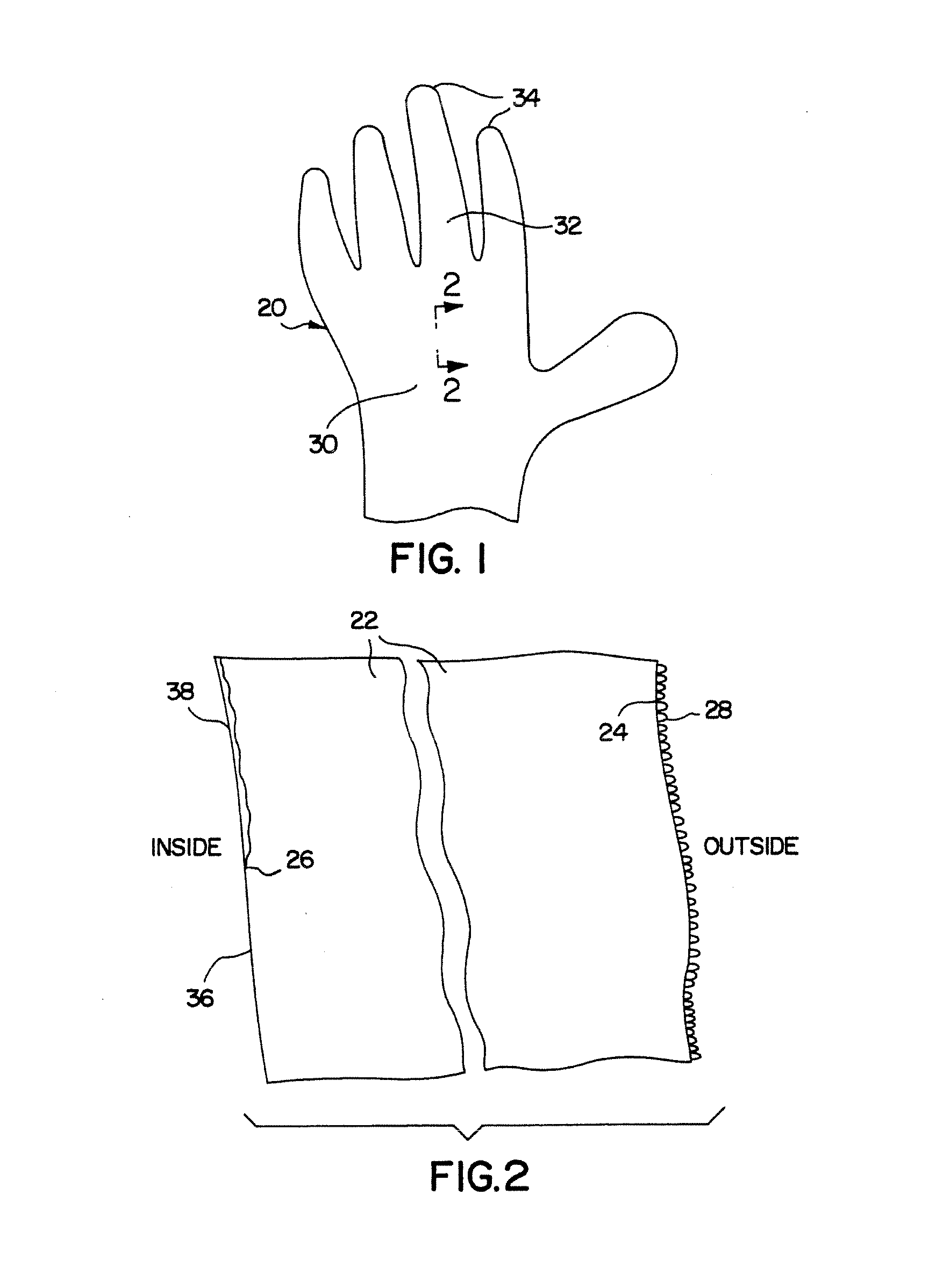[0005]The friction of the outside surface of the glove may instead be increased with a pattern of shallow ridges or the like on the outside surface. These features reduce the sensitivity of feel for the user of the glove, which is unacceptable for many applications such as medical and sensitive manufacturing operations.
[0007]This invention provides a surface-modified elastomeric article, such as a glove, and a method for its manufacture. The approach of the invention increases the
surface friction of the outside surface of the glove. The approach is fully consistent with the use of powder-free manufacturing techniques and in those cases meets governmental requirements for powder-free articles. The improved outside-
surface friction is achieved without modifying the basic
physical structure of the article, without loss of the existing advantageous properties of the article, and with little increased cost. The treatment to achieve improved
surface friction on some surfaces of the article may be applied in conjunction with other treatments of other surfaces of the article. For example, the outside surface of a glove may be treated to increase its friction, and the inside surface may be separately treated to improve its donnability without losing the increased friction on the outside surface. The mechanical properties of the basic glove are not sacrificed in order to attain improved donnability and grip retention. The
surface modification of the article can also be made to increase the dissipation of static electrical charge, reducing the incidence of damage due to such static electrical charges. The processing approach leads to excellent consistency in batches of manufactured gloves.
[0010]In one embodiment, the
colloidal silica particles are themselves provided or treated so as to have some electrical
conductivity. The electrical
conductivity may be produced by depositing a partially conductive layer onto the surfaces of the particles, such as a thin
surface layer of aluminum chlorhydrate. The electrical
conductivity of the partially conductive
colloidal silica particles improves the
electrostatic discharge (ESD) properties of the article permitting static charge to dissipate more rapidly and completely than would otherwise be the case. Dissipation of static charge is an important requirement in many applications of elastomeric articles such as gloves, inasmuch as accumulated static charge in medical facilities or manufacturing plants may adversely affect treatments,
instrumentation, and / or products.
[0012]In the preferred embodiment, the mold is a glove shape former. The coating composition includes a coagulant having the
colloidal silica particles mixed therewith. The mixture of coagulant and colloidal silica particles is applied to the surface of the glove former, which is dipped into the flowable
elastomer and withdrawn, and the coagulated
elastomer forms the matrix of the glove. The glove matrix is turned inside out, with the result that the outside surface has the plurality of colloidal silica particles thereon. Before it is turned inside out, the exposed surface of the glove matrix, which later becomes the inside surface of the glove, may be treated to improve handling characteristics and donnability with either powder-based or powder-free methods.
[0013]The present invention thus provides articles and a method for producing articles that have a surface selectively covered with colloidal silica particles. Chemical or coating-type powder-free de-tackifying treatments to the inside surface of the glove, even where they also are applied to the outside surface, do not adversely affect the gripping enhancement of the silica particles on the outside surface of the glove. The gripping enhancement is based on the
physical structure at the outside surface, not on
chemical effects. The present approach therefore allows powder or powder-free treatments to be applied to the glove, enhancing manufacturability, shipping, and donnability, while simultaneously achieving excellent grip retention even when the glove is wet.
[0014]The particles are selectively present on the surface of the article to provide increased friction. In presently preferred applications, no other material in the form of a binder is used to bind the colloidal silica particles to the surface of the article. On the other hand, carefully chosen surface coatings may be used to achieve particular results. Examples are polyether or
polyester polyurethanes and certain extensible
acrylate-based copolymers. To enhance ESD properties other additives such as
metal oxides,
alkali metal salts such as
lithium nitrate and
polyethylene ether glycols may be employed. The colloidal silica particles are present only on the treated surfaces, and do not extend through the body or thickness of the matrix. If the colloidal silica particles were mixed through the entire thickness of the article, there would be a potential for adverse effects on the mechanical properties of the article due to the high
volume fraction of particles present. The present approach selectively positions the particles on the surface of the article where they are required to increase friction and / or for electrical charge dissipation.
 Login to View More
Login to View More 


